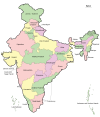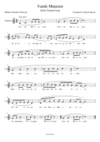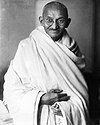National symbols of India
The
Republic of India
.
List of national and official symbols
| Symbol | Name | Image | Adopted | Notes |
|---|---|---|---|---|
| Official name | Republic of India (Bhārat Gaṇarājya)[1]
|
 |
26 January 1950[2] | The Constitution of India uses the official names of India and Bharat.[3]
According to the The term Bharat (Bhārat, mentioned in the Indian epic poetry is used in its variations by many Indian languages. A modern rendering of the historical name Bharatavarsha, Bharat gained increased currency from the mid-19th century as a native name for India.[5] |
| National flag | Flag of India[1] |  |
15 August 1947 ( Republic of India )
|
A horizontal rectangular India green at the bottom with the Dharma Chakra, a 24-spoke wheel, in navy blue at its center.[1] The ratio of width of the flag to its length is two to three. Saffron indicates the strength and courage, white represents peace, green expresses fertility, growth and auspiciousness with Chakra representing truth.[7] The flag is based on the Swaraj flag design proposed by Pingali Venkayya.[8]
|
| National emblem | State Emblem of India[9] |  |
30 December 1947 ( Republic of India )
|
An adaptation of Lion Capital of Ashoka at Sarnath consisting of four Asiatic lions standing back to back, symbolizing power, courage, confidence and faith.[11] The lions are mounted on a circular abacus over a bell-shaped lotus. The abacus has a frieze carrying the reliefs of an elephant, a galloping horse, a bull and a lion with a Dharma chakra in the middle.[9][7]
The motto "Satyameva Jayate" (English: Truth Alone Triumphs) is a quote taken from |
| National motto | Satyameva Jayate ("Truth Alone Triumphs")[9] | |||
| National anthem | Jana Gana Mana ("Thou Art the Ruler of the Minds of All People")[13] |
 |
24 January 1950 ( Republic of India )
|
"Jana Gana Mana" is taken from Calcutta.[16] The first stanza of the song Bharoto Bhagyo Bidhata was adopted by the Constituent Assembly of India as the National Anthem on 24 January 1950.[14] The national anthem is played in approximately 52 seconds.[7]
|
| National song | Vande Mataram ("I bow to thee, O Mother!")[17] |
 |
24 January 1950 ( Republic of India )
|
Vande Mataram is a Anandmath.[18] The poem played a vital role in the Indian independence movement and gained political significance when it was recited by Rabindranath Tagore in 1896.[19] The first two verses of the song were adopted as the National Song of India On 24 January 1950 by the Constituent Assembly of India.[7]
|
National days
|
Independence Day[1] |  |
15 August 1947 | The Constituent Assembly of India met at 11 pm on 14 August in the Constitution Hall in New Delhi which was chaired by Rajendra Prasad. In this session, Jawaharlal Nehru delivered the Tryst with Destiny speech proclaiming India's independence.[20][21] The Dominion of India became an independent country on 15 August 1947 as official ceremonies took place in New Delhi.[22] |
| Republic Day[1] |  |
26 January 1950 | Republic Day commemorates the adoption of the Constitution of India and the country's transition to a republic on 26 January 1950.[23][24] The date was chosen as the Indian National Congress proclaimed Purna Swaraj (complete independence) on this day in 1930.[25] | |
| Gandhi Jayanti[1] |  |
2 October | Gandhi Jayanti is celebrated to mark the birthday of Mahatma Gandhi, the "Father of the nation". Gandhi espoused one of the most well known philosophies of nonviolent resistance and played a key role in Indian Independence movement.[26] | |
| Oath of allegiance | National Pledge[27] |  |
26 January 1965[28] | It was written in Telugu by Pydimarri Venkata Subba Rao in 1962.[29] Central Advisory Board on Education directed that the pledge to be sung in Schools and that this practice to be introduced by 26 January 1965.[30] |
| National currency | Indian Rupee[31] |  |
15 August 1947 15 July 2010 (symbol)[31] |
Indian rupee (ISO code: INR) is the official currency of India, the issuance of which is controlled by the Reserve Bank of India. Rupee is derived from rupya or rūpiya, which was used to denote various coins in usage since 4th century B.C.[32] The Indian rupee symbol, adopted in July 2010, is a combination of Devanagari "Ra" and the Roman letter "R" with two parallel horizontal lines at the top which represent the national flag and indicate equality.[31] |
| National calendar | Indian National Calendar[33] |  |
22 March 1957[33] | The Indian national calendar is based on the Hindu calendar and has 365 days across 12 months.[34] It is used, alongside the Gregorian calendar, by The Gazette of India, in news broadcasts by All India Radio and in calendars and communications issued by the Government of India.[33]
|
| National animal | Bengal tiger (Panthera tigris)[7] |  |
April 1973[35] | The tiger was chosen as the national animal in a meeting of the Indian Board for Wildlife in 1972 and was adopted officially in April 1973. It was chosen over the Asiatic lion due to the wider presence of the tiger across India.[36][35] Tiger is one of the big cats and consists of prominent black stripes on a yellow coat.[37] As of 2023, India is home to almost 75% of the world's wild tiger population.[38] |
| National bird | Indian peafowl (Pavo cristatus)[7] |  |
1 February 1963[39] | Indian peacock is designated as the national bird of India in February 1963. |
| National heritage animal | Indian elephant (Elephas maximus indicus)[43] |  |
22 October 2010[44] | Indian elephant is the largest terrestrial mammal in India and was declared as the national heritage animal of India since 22 October 2010.[45][44] The Indian elephant is native to mainland Asia with nearly three-fourth of the population found in India.[46][47] The Indian elephant is a cultural symbol throughout its range and appears in various religious traditions and mythologies.[48][49] |
| National flower | Lotus (Nelumbo nucifera)[50]
|
 |
1950[51] | Lotus is an flood plains. Lotus seeds can remain dormant and viable for many years and rehydrate to begin a new lotus colony when favorable circumstances return. The oldest recorded lotus germination from seeds 1,300 years old have been recorded and therefore the plant is regarded as a symbol of longevity.[52] Therefore, the Chinese regard the plant as a symbol of longevity. It is a sacred flower and occupies a unique position in the art and mythology of ancient India and has been an auspicious symbol of Indian culture.[53]
|
| National tree | Indian Banyan (Ficus benghalensis)[50] |  |
1950 | Indian banyan is a tree native to the Indian subcontinent and is among the largest trees in the world by canopy coverage. It produces aerial roots which grow downwards as aerial roots on the branches that grow downward like lianas.[54] Because of this characteristic and its longevity, this tree is considered immortal and is an integral part of the myths and legends of India.[55] The Banyan tree is said to symbolize unity denoted by the tree's structure and deep roots. The banyan tree gives shelter to various organisms and denotes India and its people from different backgrounds.[50] |
| National fruit | Mango (Mangifera indica)[50] |  |
1950 | Mango is a large fruit tree with many varieties.[56] It is believed to have originated in Northeast India.[57][58] It has been cultivated in India since ancient times and is known for its deliciousness.[50] It is considered an economically important fruit in India and India is the largest producer of mangoes worldwide.[59] |
| National aquatic animal | Ganges river dolphin (Platanista gangetica)[60] |  |
18 May 2010[61] | The Ganges river dolphin is an endangered freshwater or Brahmaputra rivers in India. It was announced as the national aquatic animal in 2010 to raise awareness towards its conservation.[61]
|
| National reptile | King cobra (Ophiophagus hanna)[43] |  |
1972 | King Cobra is a |
| National river | Ganga
|
 |
4 November 2008[64] | The Ganges rises in the western |
| National microbe | Lactobacillus delbrueckii subsp. bulgaricus[69] |  |
18 October 2012[69] | Lactobacillus bulgaricus is a |
| National game | None[72] Field hockey[50] |
 |
Field hockey is a team sport in which each team plays with 11 players in total in which teams must move a hockey ball around a field by hitting it with a hockey stick towards the rival team's shooting circle and then into the goal. |
See also
References
- ^ a b c d e f "India at a glance". Government of India. Retrieved 1 December 2023.
- ^ "The Constitution of India" (PDF). Ministry of Law and Justice. 1 December 2007. Archived from the original (PDF) on 9 September 2014. Retrieved 3 March 2012.
Article 1(1): India, that is Bharat, shall be a Union of States.
- ^ "India, that is Bharat: A short history of the nation's names, from the Rig Veda to the Constitution of India". The Indian Express. 9 September 2023. Retrieved 1 December 2023.
- ^ "India (noun)". Oxford English Dictionary (3rd ed.). 2009.
- ISBN 978-1-317-49034-0.
- OCLC 1567377.
- ^ a b c d e f g "National Symbols". Government of India. Retrieved 14 August 2022.
- ISBN 978-8-193-60091-7.
- ^ a b c d "State Emblem". Government of India. Retrieved 3 April 2024.
- ^ "Press Communique' - State Emblem" (PDF). Press Information Bureau of India - Archive. Archived (PDF) from the original on 8 August 2017.
- ^ "The State Emblem Of India (Prohibition Of Improper Use) Act, 2005" (PDF). 20 December 2005. p. 4. Archived from the original (PDF) on 19 March 2013. Retrieved 15 April 2012.
- ^ "Rajya Sabha Parliamentary Standing Committee On Home Affairs: 116th Report on The State Emblem Of India (Prohibition Of Improper Use) Bill, 2004" (PDF). Archived from the original (PDF) on 8 March 2013.
- ^ "National Anthem". Government of India. Retrieved 3 April 2024.
- ^ a b Orders relating to National Anthem of India (PDF) (Report). Government of India. Retrieved 22 August 2023.
The composition consisting of the words and music of the first stanza of the late poet Rabindra Nath Tagore's song known as "Jana Gana Mana" is the National Anthem of India
- ISBN 978-81-260-1295-4.
- ^ Chowdhury, Arunangsu Roy. "100 years since 'Jana Gana Mana' was born". The Hindu. Retrieved 11 April 2021.
- ^ "National Song". Government of India. Retrieved 3 April 2024.
- ISBN 978-0-14-303055-3.
- ISBN 978-0-385-53190-0.
- ^ "Constituent Assembly of India Volume V". Parliament of India. Archived from the original on 4 September 2013. Retrieved 15 August 2013.
- ^ "Jawaharlal Nehru (1889–1964): Speech On the Granting of Indian Independence, August 14, 1947". Fordham University. Archived from the original on 18 August 2012. Retrieved 26 July 2012.
- ISBN 978-0-230-01654-5.
- ^ Constitution of India (PDF) (Report). Government of India. Retrieved 1 December 2023.
- ^ "Republic Day, January 26: History, Significance & Celebration". The Times of India. 25 January 2020. Retrieved 24 January 2021.
- Britannica. Retrieved 1 December 2023.
- ^ "UN declares 2 October, Gandhi's birthday, as International Day of Non-Violence". United Nations. 15 June 2007. Retrieved 9 October 2014.
- ^ "The 'Pledge', now 50, is the pride of Telugus!". The Hindu. 14 September 2012. Retrieved 1 December 2023.
- ^ "Do you know we have a National Pledge?". Hindustan Times. 20 February 2022. Retrieved 1 December 2023.
- Times of India. 14 September 2012. Retrieved 7 August 2021.
- ISBN 978-81-7022-066-4. Retrieved 27 January 2012.
- ^ a b c "Currency symbol". Government of India. Retrieved 3 April 2024.
- Astadhyayidoes not specifically state.
- ^ a b c "National Calendar". Government of India. Retrieved 3 April 2024.
- ^ "Report of the Calendar Reform Committee". Council of Scientific and Industrial Research, New Delhi. 1955. pp. 255–256.
- ^ a b "Tiger grabbed lion's national animal status". The Times of India. 18 January 2017. Retrieved 1 December 2023.
- ^ "Royal Bengal Tiger: The National Animal of India". Jagranjosh. 18 November 2019. Retrieved 1 December 2023.
- ^ "National Animal". Government of India. Retrieved 3 April 2024.
- ^ Qureshi, Q.; Jhala, Y. V.; Yadav, S. P. & Mallick, A. (2023). Status of tigers, co-predators and prey in India 2022 (PDF) (Report). New Delhi, Dehradun: National Tiger Conservation Authority & Wildlife Institute of India.
- ^ "Why peacock is considered the national bird". News9. 14 August 2023. Retrieved 1 December 2023.
- ^ "National Bird". Government of India. Retrieved 3 April 2024.
- ISBN 1-4067-4576-6.
- ^ Blanford, WT (1898). The Fauna of British India, Including Ceylon and Burma. Birds. Vol. 4. Taylor and Francis, London. pp. 681–70.
- ^ a b "Significant symbols". The Hindu. 8 August 2011. Retrieved 1 December 2023.
- ^ a b "Elephant declared national heritage animal". Hindustan Times. 10 October 2010. Retrieved 1 December 2023.
- ^ "MOEF to Declare Elephant as National Heritage Animal" (Press release). Government of India. 31 August 2010. Retrieved 1 December 2023.
- ^ "Indian elephant". WWF. Retrieved 1 December 2023.
- ^ "India has 27,312 elephants, census shows". The Hindu. 16 August 2017. Retrieved 1 December 2023.
- ^ DeVito, Carole; DeVito, Pasquale (1994). India - Mahabharata. Fulbright-Hays Summer Seminar Abroad 1994 (India). United States Educational Foundation in India. p. 4.
- ISBN 978-81-900184-3-2.
- ^ a b c d e f g "National symbols of India". Government of India. Retrieved 1 December 2023.
- ^ "Lotus flower is associated with India's cultural identity". Deccan Herald. 13 November 2022. Retrieved 1 December 2023.
- PMID 21669732.
- ^ "Sacred Lotus". Encyclopædia Britannica. 4 May 2023.
- ^ "Ficus benghalensis". Royal Botanic Gardens KEW Plants of the World Online. Retrieved 19 June 2022.
- ^ "National Tree". Government of India. Archived from the original on 22 January 2013. Retrieved 3 April 2012.
- ^ Morton, Julia F. (1987). "Mango (Mangifera indica L.)". In: Fruits of Warm Climates; New Crop Resource Online Program, Center for New Crops and Plant Products, Purdue University. pp. 221–239. Retrieved 24 December 2021.
- PMID 28473837.
- PMID 30730057.
- ^ "FAO statistics". FAO. Retrieved 24 March 2024.
- ^ "Dolphin becomes India's national aquatic animal". Archived from the original on 8 October 2009.
- ^ a b Dolphin Declared National Aquatic Animal (PDF) (Report). Government of India. Retrieved 3 April 2024.
- ISBN 978-0-195-38037-8.
- ISBN 978-0-684-16626-1.
- ^ "First anniversary of Ganga being declared as National River of India". The Times of India. 4 November 2009. Retrieved 1 December 2023.
- ISBN 978-1-135-76883-6.
- ISBN 978-1612283685. Archivedfrom the original on 28 March 2024. Retrieved 22 March 2017.
- ISBN 978-0-15-100585-7. Archivedfrom the original on 24 March 2023. Retrieved 30 July 2013.
- ISBN 978-81-250-0781-4. Archivedfrom the original on 28 March 2024. Retrieved 27 April 2011.
- ^ a b "Education for Biodiversity Conservation". Government of India. Retrieved 1 December 2023.
- ISSN 0001-7213.
- doi:10.17306/J.AFS.2017.0512.)
{{cite journal}}: CS1 maint: multiple names: authors list (link - ^ a b "Hockey is not our national game: Ministry". The Times of India. 2 August 2012. Retrieved 1 December 2023.
- ^ "Indian field hockey records". Archived from the original on 14 August 2021. Retrieved 14 August 2021.
- ^ "Govt to review its portal article on hockey as national game". Business Standard. 23 January 2012. Retrieved 1 December 2023.
External links
- National Symbols. Know India Programme.
- National Symbols. Govt. of IndiaOfficial website.

